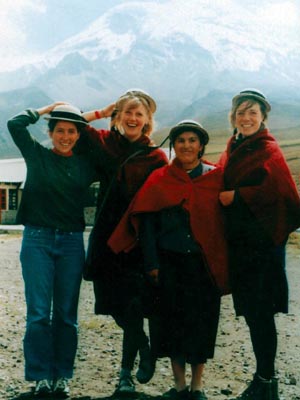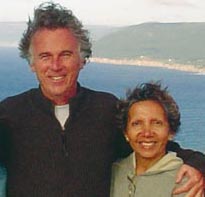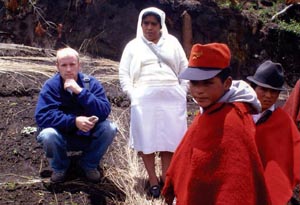MAKING A DIFFERENCE
Many Canadian volunteers go overseas on a pilgrimage of service
By Thomas Walsh
March 2005
Return to Table of Contents
Print Article
Making a difference in the lives of the less fortunate is taking on an increasingly international dimension. The Internet, television, international studies programs and a multicultural society encourage adventurous Canadians to live the difficult reality of the global South alongside the people of Asia, Africa and Latin America. High school and university students and graduates, young families, early retired people, all constitute a wave of volunteers.
Jesus taught us in the Beatitudes that peacemakers will be called children of God, and that those who hunger and thirst for righteousness will be filled.a clear message urging action on behalf of the poor and persecuted. I think this call motivates many of the older volunteers to go overseas. Many leave a comfortable lifestyle, pay their own airfare, and reach into their pockets to give of their time and skills.

Evita Walsh (Thomas and Julia's daughter), Corrine and Sarah with Maria, a Puruhae indigenous woman.
Here in Ecuador, Eileen and Sharon, retired psychologists, offered their services to women and children faced with domestic violence. Stephen, an expert in farm machinery, with the financial support of his parish, spent three years training young Andean indigenous men and women to repair everything from a tractor to a water pump. Clive, a retired physics engineer, is helping to design and build solar collectors so that indigenous women can dry and mill the organic herbal plants they grow. Christopher and Gillian moved into the diocesan seminary and set to work renovating it and establishing a vegetable garden that the seminarians cultivate. Michael, a retired doctor, helped to set up a hospital outreach program and train rural health promoters. The Rotary Club of Barrie, Ontario, raised money for a drinking water project for a community and came here to help build the system. Marie, Louise, René and Marten, all professionals, return yearly to assist the people in community projects, doing fundraising and hands-on work.
A number of these projects have received substantial financial support from the Canadian International Development Agency (CIDA) - the Canadian government's overseas aid program. The projects are aimed at helping the poorest people here in Chimborazo province to better their economic and social conditions, and are set up in a way that is easy for volunteers to become involved.
This is the case of Jambi Kiwa, a growers' cooperative that received substantial financial help from CIDA, the Comart Foundation, CECI (Canadian Centre for International Studies and Cooperation) and Scarboro Missions. Jambi Kiwa organically cultivates and processes medicinal and aromatic plants to be sold as teas and medicines.
There are four Canadian volunteers at the Jambi Kiwa facility: Pearce, a McGill University civil engineering graduate helping Clive design and build solar dryers; Orissa, a British Columbia University chemistry graduate helping set up quality control systems; Emmanuelle, a Sherbrooke University graduate interested in natural medicine and midwifery; and Sarah, a Trent University intern redoing the web pages and offering English classes to Jambi Kiwa's employees. In these internships, volunteers acquire cross-cultural experiences, new languages, values, and friendships.
A thirst for justice
Today's youth demonstrate commitment and a thirst for justice in their involvements. For example, students at Pearson's United World College in Victoria, British Columbia, do a gap year as teachers' assistants in rural indigenous schools on the lunar landscapes of Mount Chimborazo, at altitudes higher than the Rockies.

Tom and Julia Duarte-Walsh
Thirty-five youth from Canada, Japan and the United States, all with the organization Kids Can Free the Children, spent three weeks visiting schools that they raised funds for back home.
CEGEP college students from Montreal have helped map and build interpretation trails on the mountain, worked in rural schools and visited sacred indigenous sites.
Last summer, the Comart Foundation with the support of the United Church of Canada organized a faith-filled journey for 20 young Canadians to work for three weeks on the building of the new Jambi Kiwa factory. They also helped the medicinal plant growers in their gardens.
Even though it was shovel-in-hand and down and dirty in the trenches, there was no complaining as the young people worked shoulder to shoulder with the local people. Lunch time was reserved for soccer games between the Canadians and the Ecuadorians. At night, visitors and hosts shared songs, some belonging to the Andean mass and others composed by the Canadians.
A spiritual quest
Although not always articulated, a spiritual quest is part of this pilgrimage to serve. Volunteers seek vitality in a simpler lifestyle where people live community values. They try to unravel how the indigenous people, the poorest of the poor in Ecuador, can express such joyfulness and hospitality in their lives. Pierre Gougoux who led the group of CEGEP students told them, "Many of you will be returning to Canada having done a lot less than you expected to do and having learned a lot more than you expected to learn."

Coady International Institute student Aaron Steeghs and Sister Elena visit a school garden supported by Kids Can Free the Children.
In our contact with younger volunteers, my wife Julia and I (see photo facing page) are interested in knowing what young people raised in a consumer society such as Canada think of religious issues. Some have had no religious instruction whatsoever. And in a consumer society with countless distractions, who has time to pray?
The Irish Benedictine monk John Main, writing about monastic prayer, seems to refer to this modern day reality when he says that by losing touch with our own roots of prayer our lives become progressively more lifeless and arid. He goes on to explain:
"But in the marvelous economy of the redemptive mystery, whenever this does happen it never totally extinguishes the miracle of the personal experience of God's power at work in the world... There seems to be a merciful spiritual law that determines that whenever a Christian centre loses its vitalizing contact with the Tradition, it loses both its own vitality and its position as a 'centre' in the Christian community at large: the consciousness of the Spirit that gives it its power is transferred and descends elsewhere 'as it wills.'"
For those familiar with recent Latin American history with its countless martyrs, imprisoned bishops, liberation theology and vibrant Christian base communities, it is clear that the Spirit is alive and well.
It was here in Latin America that it was first articulated that God has a preferential option for the poor. The Church later recognized this as a universal principal. It took the assassination of El Salvador's Archbishop Oscar Romero for the world to take notice of the brutality being afflicted on Latin America's poor by US-backed military dictatorships.
This year, on the 25th anniversary of Romero's death, what have we of the affluent societies learned about reaching out to the people of the global South? I think part of this learning is taking place in the massive presence of volunteers willing to walk with the people.
Thomas Walsh joined Scarboro Missions in 1975. He and his wife Julia Duarte have served in Peru, Panama, Canada and now Ecuador. They have four children.
CCIC (Canadian Council of International Cooperation) www.ccic.ca; Tel: (613) 241-7007.
CECI (Centre of Canadian International Studies) www.ceci.ca; Tel: (514) 875-9911.
Scarboro Missions, Tel: 1-800-260-4815 www.scarboromissions.ca
Return to Table of Contents
Print Article